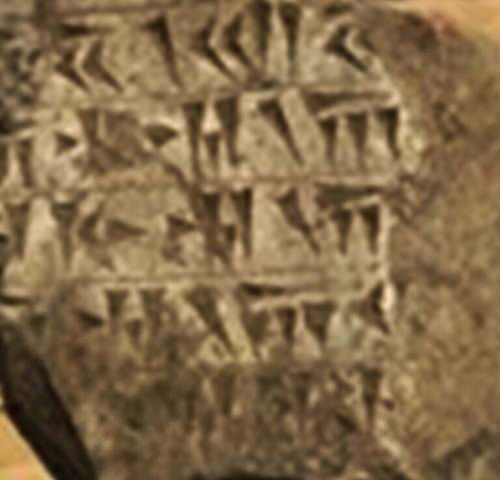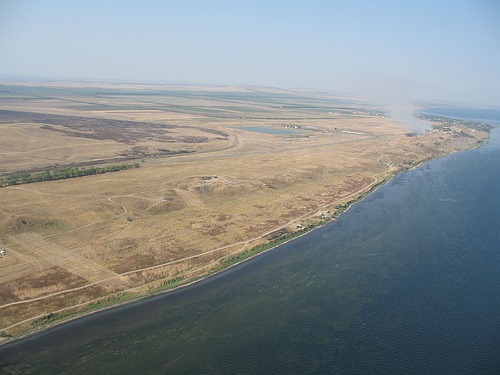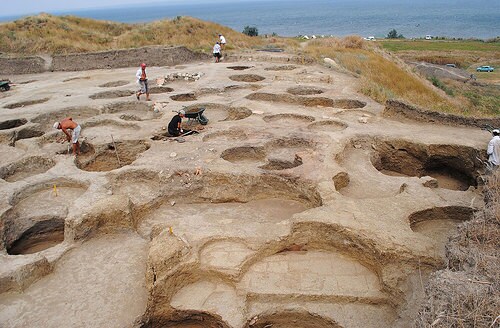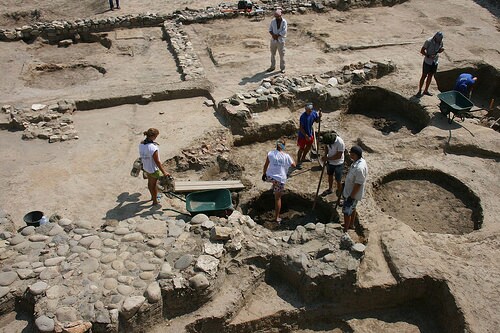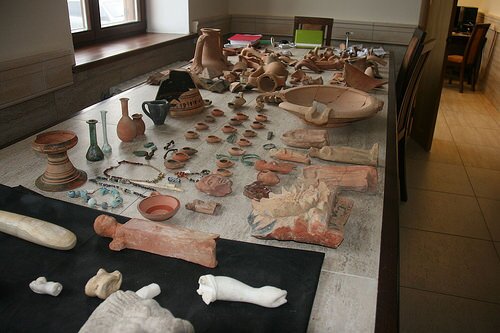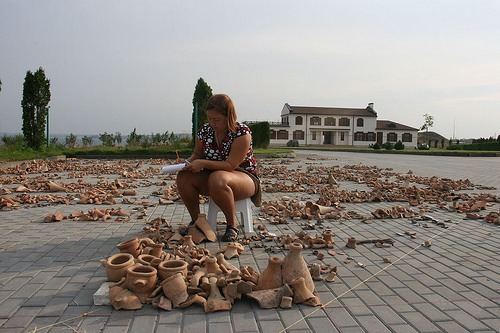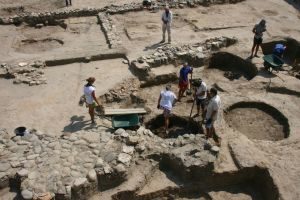
Anapa, August 9, 2016 – Archaeologists under the auspices of the Oleg Deripaska Volnoe Delo Foundation and the Russian Academy of Sciences‘ Institute of Archaeology have discovered fragments of a marble stele carrying an inscription of the ancient Persian King Darius I. Found among the remains of the ancient town of Phanagoria, an ancient Greek city near Crimea and the Black Sea in the Krasnodar region of Southern Russia, the stele is dated to the first half of the 5th century B.C.E.
The decoded inscriptions (shown right), in the ancient Persian language, state they were made in the name of the Persian King Darius I, who lived from 550-486 B.C. The text contains a previously unregistered word and, roughly interpreted, identifies the ancient city of Miletus, one of the biggest cities in Ionia, a region later known as Asia Minor. Miletus stood at the head of the so-called Ionian uprising of Greek city states against Darius I. It was suppressed in 494 B.C.
Archaeologists suggest the king erected a marble stele in the city after his victory over the Greeks. The monument featured an incribed text procaiming the king’s triumph. Later on, suggest the archaeologists, a fragment of the overturned and broken stele reached Phanagoria, quite possibly as ballast on a ship that called into the Phanagoria port, as there is no natural stone of the kind on the Taman peninsula. “The inscription on the stele made in the name of King Darius I is evidently devoted to the crushing of the Ionian revolt,” says Vladimir Kuznetsov, director of the Phanagorian expedition. “The discovery places Phanagoria in the context of one of the most important events of ancient history, which had far-reaching consequences for the Greeks as well as the Persians, and makes it possible to trace the connections of this colony with other parts of the Greek world and analyze its significance in advancing Hellenistic civilization on the Black Sea coast.”
The stele is currently undergoing scrutiny at the restoration laboratory of the Phanagoria Research and Cultural Center.
Apart from the stele, archeologists have uncovered the remains of ancient fortress walls in the acropolis. Among the recent discoveries made at Phanagoria are remains of a palace of Mithradates VI dated the 1st century B.C.; an ancient naval ram used by the army of Mithradates VI; a tomb with a stepped ceiling; the oldest temple unearthed on Russian territory, dating back to the 5th century B.C.; and a number of submerged objects, such as the ancient city’s streets covered with sand, port structures, and ship debris.
________________________________________
Bird’s eye panorama of the Phanagoria archaeological site. Courtesy Oleg Deripaska Volnoe Delo Foundation and the Russian Academy of Sciences’ Institute of Archaeology.
___________________________________________________
Remains of a building dated to the 5th century, with Roman holes. Courtesy Oleg Deripaska Volnoe Delo Foundation and the Russian Academy of Sciences’ Institute of Archaeology.
____________________________________________________
Part of Phanagoria’s ancient center. Courtesy Oleg Deripaska Volnoe Delo Foundation and the Russian Academy of Sciences’ Institute of Archaeology.
_________________________________________________
The excavations cover several areas, including the 2,500-square-meter acropolis at the center of the ancient city, the eastern necropolis, an ancient cemetery that served as a burial place from the very founding of the city, and a submerged part of the city. What makes the expedition unique is the mix of diversified specialists working together. Apart from archeologists and historians, there are anthropologists, soil scientists, paleozoologists, numismatists and other researchers. A complex approach to the study of Phanagoria’s cultural relics has shed light on understanding the residents’ way of living, religious beliefs, economic cooperation, as well as their roles in military conflicts.
Phanagoria was one of the major monumental cities on presnt-day Russian soil. Founded in the mid-sixth century B.C. by Greek colonists, the city has long been one of two capitals of the Bosporan Kingdom, an ancient state located in eastern Crimea and the Taman Peninsula. Phanagoria was the major economic and cultural center of the Black Sea region, one of the biggest Greek cities, the first capital of the Great Bulgaria, and one of the main cities of Khazar Kaganate. It was also an ancient center of Christianity. Saint Andrew was believed to preach in Phanagoria. The city boasts the largest Jewish community in the Black Sea region: the first synagogue in Russia was built in Phanagoria in the 16th century C.E.
In the 9-10th centuries, the residents abandoned the city for reasons still unknown. Phanagoria is surrounded by Russia’s largest necropolis, covering an area of over 300 hectares. The total volume of the cultural layers is 2.5 million cubic meters of soil; the layer’s depth is up to seven meters. No single building has been erected in the city since ancient times, which has helped preserve the ruins and the historical artifacts.
_______________________________________
Above and below, the prolific array of artifacts unearthed at Phanagoria. Courtesy Oleg Deripaska Volnoe Delo Foundation and the Russian Academy of Sciences’ Institute of Archaeology.
____________________________________________________
Regular archeological expeditions have been conducted in Phanagoria since the late 1930s. As of now, only two percent of the city’s territory has been revealed.
Source: Edited and adapted from the subject press release.
Image, second from top, right: Inscription mentioning Darius I.
____________________________________________________
The Volnoe Delo Foundation, one of Russia’s biggest privately-held charity funds, is run by businessman and industrialist Oleg Deripaska. It has supported research activities in the 2550-year-old city of Phanagoria since 2004. The Foundation has allocated over $10 million to Phanagoria fieldwork over the past 12 years. Now Phanagoria is one of the best equipped archeological expeditions in Russia, with its own scientific and cultural center, up-to-date equipment for above-ground and underwater excavation and a diverse team of specialists involved in the fieldwork.
____________________________________________________

______________________________________________
Travel and learn with Far Horizons.
____________________________________________
This richly illustrated issue includes the following stories: Recent findings shedding new light on the whereabouts of the remains of Philip of Macedon, father of Alexander the Great; how an archaeologist-sculptor is bringing bones of the dead back to life; archaeologists uncovering town life at the dawn of civilization; an exclusive interview with internationally acclaimed archaeologist James M. Adovasio about what makes the Meadowcroft Rockshelter prominent in the ongoing search for the first Americans; what archaeologists are finding at the site of the ancient city of Gath, the home town of the biblical Philistine giant, Goliath; and how scientists are redrawing the picture of human evolution in Europe. Find it on Amazon.com.

